Co-Immobilization of Lipases with Different Specificities for Efficient and Recyclable Biodiesel Production from Waste Oils: Optimization Using Response Surface Methodology
Abstract
:1. Introduction
2. Results and Discussion
2.1. Preparation and Characterization of Co-Immobilized Lipases
2.2. Optimization of Co-Immobilization Conditions
2.3. Optimization of Biodiesel Production
3. Materials and Methods
3.1. Materials
3.2. Synthesis and Functionalization of Fe3O4 Magnetic Nanoparticles
3.3. Preparation of Magnetic Co-Immobilized Lipases
3.4. Transesterification Activity of Magnetic Co-Immobilized Lipases
3.5. Hydrolysis Activity of Magnetic Co-Immobilized Lipases
3.6. Optimization of Co-Immobilization Conditions Using Response Surface Methodology
3.7. Characterization of Co-Immobilized Lipases
4. Conclusions
Author Contributions
Funding
Institutional Review Board Statement
Informed Consent Statement
Data Availability Statement
Acknowledgments
Conflicts of Interest
References
- Clifford, M.; Prakash, R.; Rai, M.P. Latest advances and status analysis of nanomaterials for microalgae photosystem, lipids and biodiesel: A state of art. J. Environ. Chem. Eng. 2023, 11, 109111. [Google Scholar] [CrossRef]
- He, Y.; Li, K.; Wang, J.; Xu, L.; Yan, J.; Yang, M.; Yan, Y. A novel strategy for biodiesel production by combination of liquid lipase, deep eutectic solvent and ultrasonic-assistance in scaled-up reactor: Optimization and kinetics. J. Clean. Prod. 2022, 372, 133740. [Google Scholar] [CrossRef]
- Avargani, V.M.; Zendehboudi, S.; Saady, N.M.C.; Dusseault, M.B. A comprehensive review on hydrogen production and utilization in North America: Prospects and challenges. Energy Convers. Manag. 2022, 269, 115927. [Google Scholar] [CrossRef]
- Yang, N.; Sheng, X.; Ti, L.; Jia, H.; Ping, Q.; Li, N. Ball-milling as effective and economical process for biodiesel production under Kraft lignin activated carbon stabilized potassium carbonate. Bioresour. Technol. 2023, 369, 128379. [Google Scholar] [CrossRef] [PubMed]
- Kumar, A.; Singh, V.P.; Srivastava, A. Quality biodiesel via biotransesterification from inedible renewable sources. J. Clean. Prod. 2022, 379, 134653. [Google Scholar] [CrossRef]
- Nazloo, E.K.; Moheimani, N.R.; Ennaceri, H. Graphene-based catalysts for biodiesel production: Characteristics and performance. Sci. Total Environ. 2023, 859, 160000. [Google Scholar] [CrossRef]
- Mohan, K.; Sathishkumar, P.; Rajan, D.K.; Rajarajeswaran, J.; Ganesan, A.R. Black soldier fly (Hermetia illucens) larvae as potential feedstock for the biodiesel production: Recent advances and challenges. Sci. Total Environ. 2023, 859, 160235. [Google Scholar] [CrossRef]
- Naghipour, A.; Ghorbani-Choghamarani, A.; Taherinia, Z. Novel hybrid materials based on mesoporous Gamma-Alumina@ Riboflavin@ vanadium for biodiesel production. Fuel 2023, 334, 26674. [Google Scholar] [CrossRef]
- Wei, H.; Wang, Q.; Zhang, R.; Liu, M.; Zhang, W. Efficient biodiesel production from waste cooking oil by fast co-immobilization of lipases from Aspergillus oryzae and Rhizomucor miehei in magnetic chitosan microcapsules. Process. Biochem. 2023, 125, 171–180. [Google Scholar] [CrossRef]
- Hajjari, M.; Tabatabaei, M.; Aghbashlo, M.; Ghanavati, H. A review on the prospects of sustainable biodiesel production: A global scenario with an emphasis on wasteoil biodiesel utilization. Renew. Sustain. Energy Rev. 2017, 72, 445–464. [Google Scholar] [CrossRef]
- Ferrero, G.O.; Faba, E.M.S.; Eimer, G.A. Biodiesel production from alternative raw materials using a heterogeneous low ordered biosilicified enzyme as biocatalyst. Biotechnol. Biofuels 2021, 14, 1–11. [Google Scholar] [CrossRef]
- Zhang, Z.; Du, Y.; Kuang, G.; Shen, X.; Jia, X.; Wang, Z.; Feng, Y.; Jia, S.; Liu, F.; Bilal, M.; et al. Lipase-Ca2+ hybrid nanobiocatalysts through interfacial protein-inorganic self-assembly in deep-eutectic solvents (DES)/water two-phase system for biodiesel production. Renew. Energy 2022, 197, 110–124. [Google Scholar] [CrossRef]
- Adnan, M.; Li, K.; Wang, J.; Xu, L.; Yan, Y. Hierarchical ZIF-8 toward immobilizing Burkholderia cepacia lipase for application in biodiesel preparation. Int. J. Mol. Sci. 2018, 19, 1424. [Google Scholar] [CrossRef] [PubMed] [Green Version]
- Zhong, L.; Jiao, X.; Hu, H.; Shen, X.; Zhao, J.; Feng, Y.; Li, C.; Du, Y.; Cui, J.; Jia, S. Activated magnetic lipase-inorganic hybrid nanoflowers: A highly active and recyclable nanobiocatalyst for biodiesel production. Renew. Energy 2021, 171, 825–832. [Google Scholar] [CrossRef]
- Touqeer, T.; Mumtaz, M.W.; Mukhtar, H.; Irfan, A.; Akram, S.; Shabbir, A.; Rashid, U.; Nehdi, I.A.; Choong, T.S.Y. Fe3O4-PDA-lipase as surface functionalized nano biocatalyst for the production of biodiesel using waste cooking oil as feedstock: Characterization and process optimization. Energies 2020, 13, 177. [Google Scholar] [CrossRef] [Green Version]
- Silva, J.M.F.; Santos, K.P.; Santos, E.S.; Rios, N.S.; Gonçalves, L.R.B. Immobilization of Thermomyces lanuginosus lipase on a new hydrophobic support (Streamline phenyl™): Strategies to improve stability and reusability. Enzym. Microb. Technol. 2023, 163, 110166. [Google Scholar] [CrossRef]
- Bolivar, J.M.; Woodley, J.M.; Fernandez-Lafuente, R. Is enzyme immobilization a mature discipline? Some critical considerations to capitalize on the benefits of immobilization. Chem. Soc. Rev. 2022, 51, 6251. [Google Scholar] [CrossRef]
- Carballares, D.; Rocha-Martin, J.; Fernandez-Lafuente, R. Preparation of a six-enzyme multilayer combi-biocatalyst: Reuse of the most stable enzymes after inactivation of the least stable one. ACS Sustain. Chem. Eng. 2022, 10, 3920–3934. [Google Scholar] [CrossRef]
- Arana-Peña, S.; Rios, N.S.; Mendez-Sanchez, C.; Lokha, Y.; Carballares, D.; Gonçalves, L.R.B.; Fernandez-Lafuente, R. Coimmobilization of different lipases: Simple layer by layer enzyme spatial ordering. Int. J. Biol. Macromol. 2020, 145, 856–864. [Google Scholar] [CrossRef]
- Arana-Peña, S.; Carballares, D.; Berenguer-Murcia, Á.; Alcantara, A.R.; Rodrigues, R.C.; Fernandez-Lafuente, R. One pot use of combilipases for full modification of oils and fats: Multifunctional and heterogeneous substrates. Catalysts 2020, 10, 605. [Google Scholar] [CrossRef]
- Poppe, J.K.; Matte, C.R.; Fernandez-Lafuente, R.; Rodrigues, R.C.; Ayub, M.A.Z. Transesterification of waste frying oil and soybean oil by combi-lipases under ultrasound-assisted reactions. Appl. Biochem. Biotechnol. 2018, 186, 576–589. [Google Scholar] [CrossRef]
- Zeng, L.; He, Y.; Jiao, L.; Li, K.; Yan, Y. Preparation of biodiesel with liquid synergetic lipases from rapeseed oil deodorizer distillate. Appl. Biochem. Biotechnol. 2017, 183, 778–791. [Google Scholar] [CrossRef] [PubMed]
- Toro, E.C.; Rodríguez, D.F.; Morales, N.; García, L.M.; Godoy, C.A. Novel combi-lipase systems for fatty acid ethyl esters production. Catalysts 2019, 9, 546. [Google Scholar] [CrossRef] [Green Version]
- Miotti, R.H., Jr.; Cortez, D.V.; Castro, H.F.D. Transesterification of palm kernel oil with ethanol catalyzed by a combination of immobilized lipases with different specificities in continuous two-stage packed-bed reactor. Fuel 2022, 310, 122343. [Google Scholar] [CrossRef]
- Binhayeeding, N.; Klomklao, S.; Prasertsan, P.; Sangkharak, K. Improvement of biodiesel production using waste cooking oil and applying single and mixed immobilised lipases on polyhydroxyalkanoate. Renew. Energy 2020, 162, 1819–1827. [Google Scholar] [CrossRef]
- Arana-Peña, S.; Carballares, D.; Morellon-Sterlling, R.; Berenguer-Murcia, N.; Alcántara, A.R.; Rodrigues, R.C.; Fernandez-Lafuente, R. Enzyme co-immobilization: Always the biocatalyst designers’ choice…or not. Biotechnol. Adv. 2021, 51, 107584. [Google Scholar] [CrossRef]
- Bilal, M.; Hussain, N.; Américo-Pinheiro, J.H.P.; Almulaiky, Y.Q.; Iqbal, H.M.N. Multi-enzyme co-immobilized nano-assemblies: Bringing enzymes together for expanding bio-catalysis scope to meet biotechnological challenges. Int. J. Biol. Macromol. 2021, 186, 735–749. [Google Scholar] [CrossRef]
- Yao, G.; Wang, X.; Yang, M.; Chen, F.; Ling, Y.; Liu, T.; Xing, S.; Yao, M.; Zhang, F. Co-immobilization of bi-lipases on magnetic nanoparticles as an efficient catalyst for synthesis of functional oil rich in diacylglycerols, phytosterol esters and α-linolenic acid. LWT-Food Sci. Technol. 2020, 129, 109522. [Google Scholar] [CrossRef]
- Shahedi, M.; Habibi, Z.; Yousefi, M.; Brask, J.; Mohammadi, M. Improvement of biodiesel production from palm oil by co-immobilization of Thermomyces lanuginosa lipase and Candida antarctica lipase B: Optimization using response surface methodology. Int. J. Biol. Macromol. 2021, 170, 490–502. [Google Scholar] [CrossRef]
- Alikhani, N.; Shahedi, M.; Habibi, Z.; Yousefi, M.; Ghasemi, S.; Mohammadi, M. A multi-component approach for co-immobilization of lipases on silica-coated magnetic nanoparticles: Improving biodiesel production from waste cooking oil. Bioprocess Biosyst. Eng. 2022, 45, 2043–2060. [Google Scholar] [CrossRef]
- Abdulmalek, S.A.; Li, K.; Wang, J.; Ghide, M.K.; Yan, Y. Co-immobilization of Rhizopus oryzae and Candida rugose lipases onto m MWCNTs@4-arm-PEG-NH2-A novel magnetic nanotube-polyethylene glycol amine composite-and its applications for biodiesel production. Int. J. Mol. Sci. 2021, 22, 11956. [Google Scholar] [CrossRef]
- Kumar, S.P.J.; Garlapati, V.K.; Banerjee, R. Enzymatic biodiesel synthesis from Trichosporon shinodae yeast through circular economy: A greener approach. Fuel 2022, 325, 124595. [Google Scholar] [CrossRef]
- Gao, R.; Sun, S.; Zhou, Y.; Che, X.; Zhang, H.; Yao, N. Low-cost liquid lipase selective deacidification of corn oil with high triglyceride yield. Process. Biochem. 2022, 122, 137–145. [Google Scholar] [CrossRef]
- Shahedi, M.; Yousefi, M.; Habibi, Z.; Mohammadi, M.; As′habi, M.A. Co-immobilization of Rhizomucor miehei lipase and Candida antarctica lipase B and optimization of biocatalytic biodiesel production from palm oil using response surface methodology. Renew. Energy 2019, 141, 847–857. [Google Scholar] [CrossRef]
- Wafti, N.S.A.; Yunus, R.; Lau, H.L.N.; Choong, T.S.Y.; Abd-Aziz, S. Enzymatic synthesis of palm oil-based trimethylolpropane ester as biolubricant base stock catalyzed by Lipozyme 435. Energy 2022, 260, 125061. [Google Scholar] [CrossRef]
- Kern, O.; Motherwell, W. A novel isocyanide based three component reaction. Chem. Commun. 2003, 24, 2988–2989. [Google Scholar] [CrossRef]
- Arco, J.D.; Alcántara, A.R.; Fernández-Lafuente, R.; Fernández-Lucas, J. Magnetic micro-macro biocatalysts applied to industrial bioprocesses. Bioresour. Technol. 2021, 322, 124547. [Google Scholar] [CrossRef]
- Toide, T.; Rosero-Navarro, N.C.; Miura, A.; Kozuka, H.; Tadanaga, K. Preparation of transparent and mechanically hard inorganic-organic hybrid thick films from 3-glycidoxypropyltrimethoxysilane and zirconium propoxide. J. Sol-Gel Sci. Technol. 2022, 104, 478–483. [Google Scholar] [CrossRef]
- Wang, J.; Li, K.; He, Y.; Wang, Y.; Han, X.; Yan, Y. Enhanced performance of lipase immobilized onto Co2+-chelated magnetic nanoparticles and its application in biodiesel production. Fuel 2019, 255, 115794. [Google Scholar] [CrossRef]
- Babaki, M.; Yousefi, M.; Habibi, Z.; Mohammadi, M.; Brask, J. Effect of water, organic solvent and adsorbent contents on production of biodiesel fuel from canola oil catalyzed by various lipases immobilized on epoxy-functionalized silica as low cost biocatalyst. J. Mol. Catal. B Enzym. 2015, 120, 93–99. [Google Scholar] [CrossRef]
- Mangiagalli, M.; Ami, D.; Divitiis, M.; Brocca, S.; Catelani, T.; Natalello, A.; Lotti, M. Short-chain alcohols inactivate an immobilized industrial lipase through two different mechanisms. Biotechnol. J. 2022, 17, 2100712. [Google Scholar] [CrossRef] [PubMed]
- Andrade, T.A.; Errico, M.; Christensen, K.V. Influence of the reaction conditions on the enzyme catalyzed transesterification of castor oil: A possible step in biodiesel production. Bioresour. Technol. 2017, 243, 366–374. [Google Scholar] [CrossRef] [Green Version]
- Séverac, E.; Galy, O.; Turon, F.; Pantel, C.A.; Condoret, J.-S.; Monsan, P.; Marty, A. Selection of CalB immobilization method to be used in continuous oil transesterification: Analysis of the economical impact. Enzym. Microb. Technol. 2011, 48, 61–70. [Google Scholar] [CrossRef] [PubMed]
- Kasche, V. Mechanism and yields in enzyme catalysed equilibrium and kinetically controlled synthesis of β-lactam antibiotics, peptides and other condensation products. Enzym. Microb. Technol. 1986, 8, 4–16. [Google Scholar] [CrossRef]
- Sangkharak, K.; Mhaisawat, S.; Rakkan, T.; Paichid, N.; Yunu, T. Utilization of mixed chicken waste for biodiesel production using single and combination of immobilized lipase as a catalyst. Biomass Convers. Biorefinery 2022, 12, 1465–1478. [Google Scholar] [CrossRef]
- Wang, N.; Zhu, L.; Wang, D.; Wang, M.; Lin, Z.; Tang, H. Sono-assisted preparation of highly-efficient peroxidase-like Fe3O4 magnetic nanoparticles for catalytic removal of organic pollutants with H2O2. Ultrason. Sonochem. 2010, 17, 526–533. [Google Scholar] [CrossRef] [PubMed]
- Mohammadi, M.; Gandomkar, S.; Habibi, Z.; Yousefi, M. One pot three-component reaction for covalent immobilization of enzymes: Application of immobilized lipases for kinetic resolution of rac-ibuprofen. RSC Adv. 2016, 6, 52838–52849. [Google Scholar] [CrossRef]
- Tacias-Pascacio, V.G.; Torrestiana-Sánchez, B.; Magro, L.D.; Virgen-Ortíz, J.J.; Suárez-Ruíz, F.J.; Rodrigues, R.C.; Fernandez-Lafuente, R. Comparison of acid, basic and enzymatic catalysis on the production of biodiesel after RSM optimization. Renew. Energy 2019, 135, 1–9. [Google Scholar] [CrossRef]
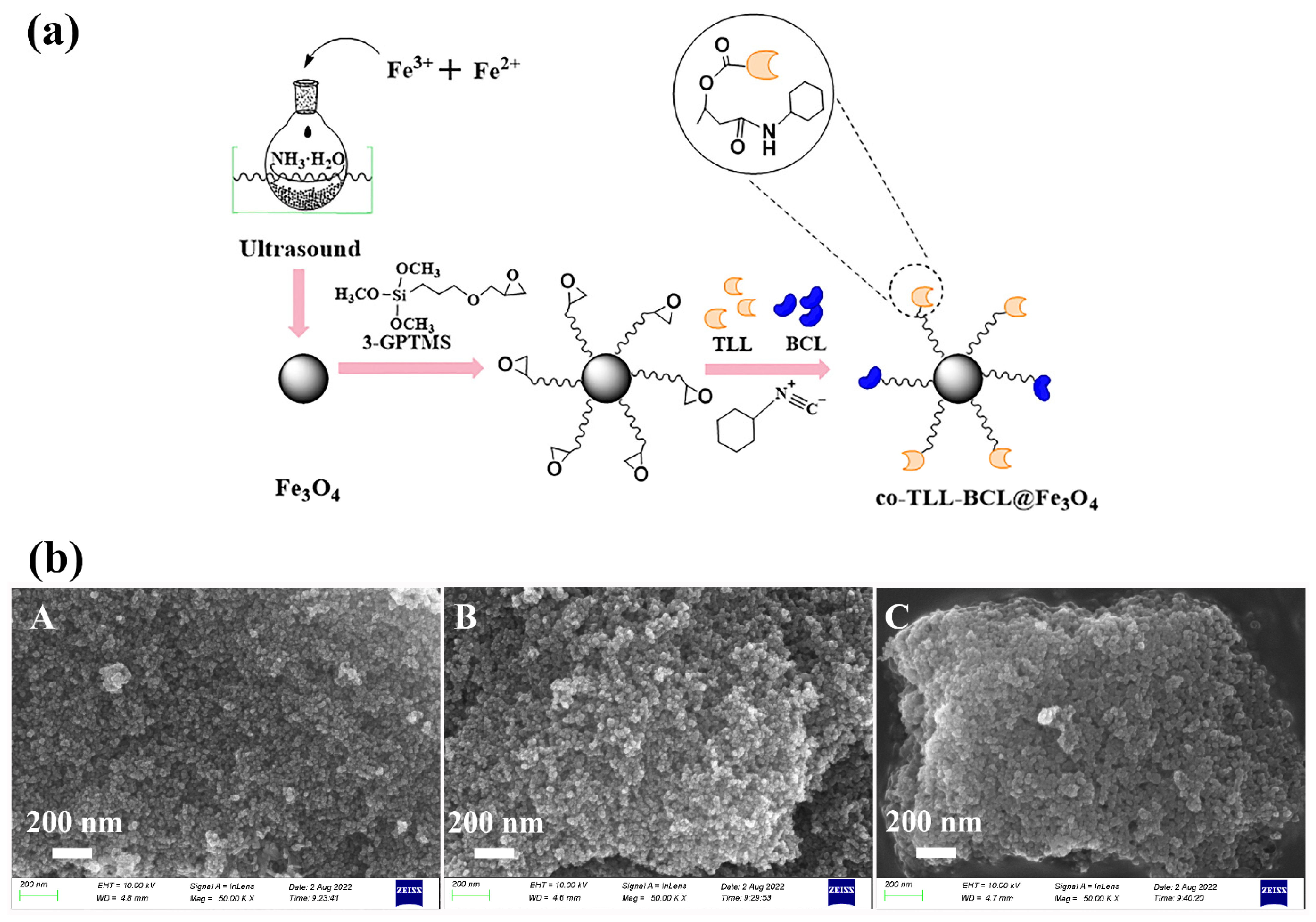
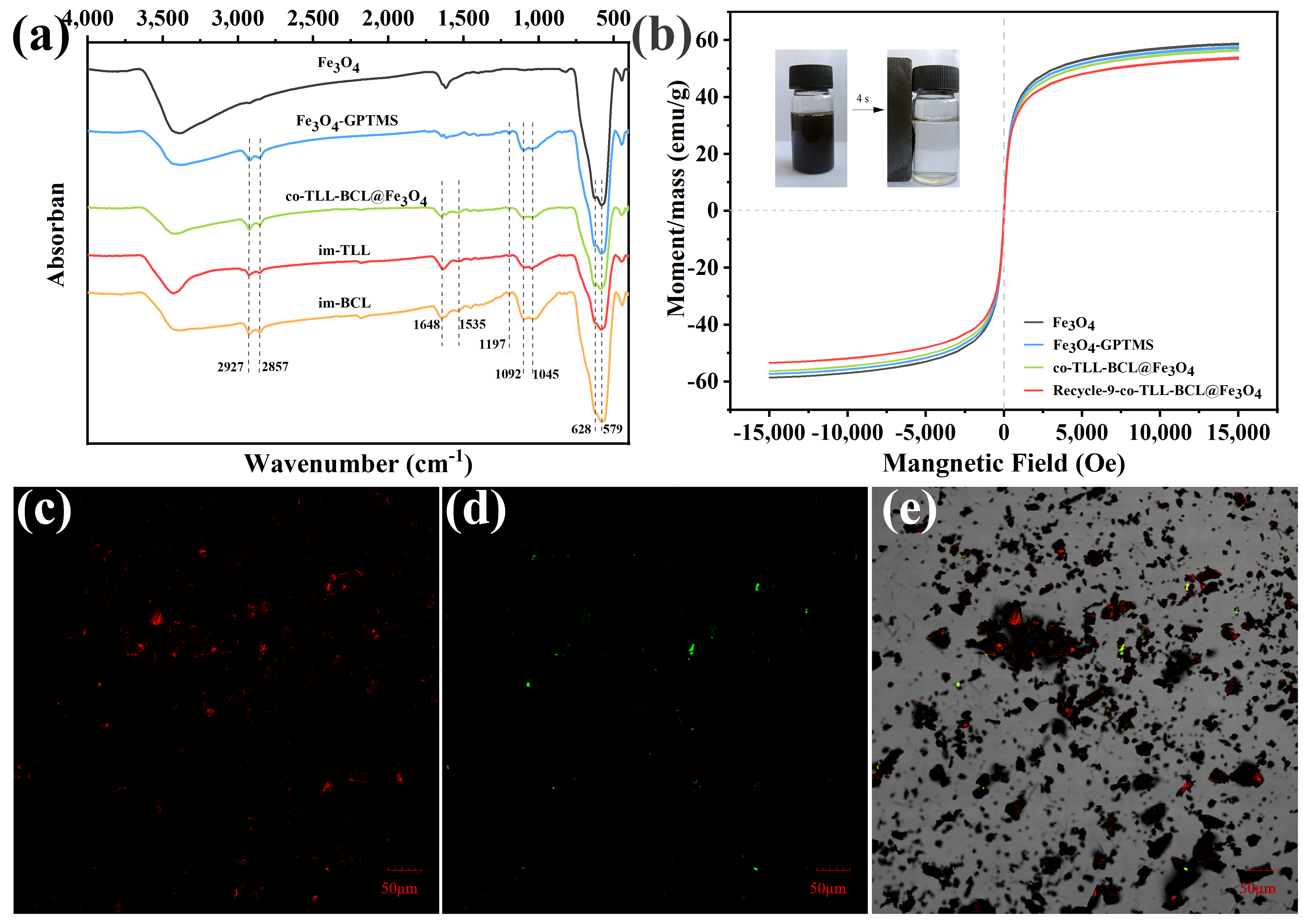


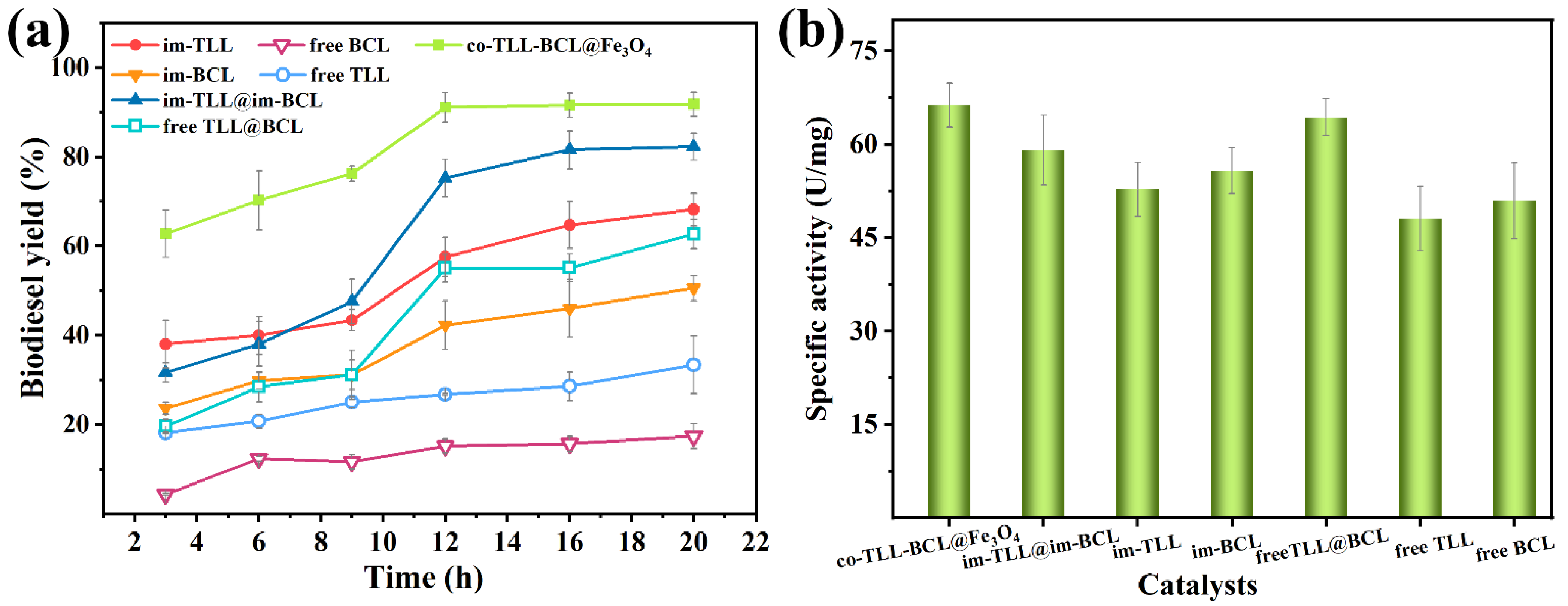

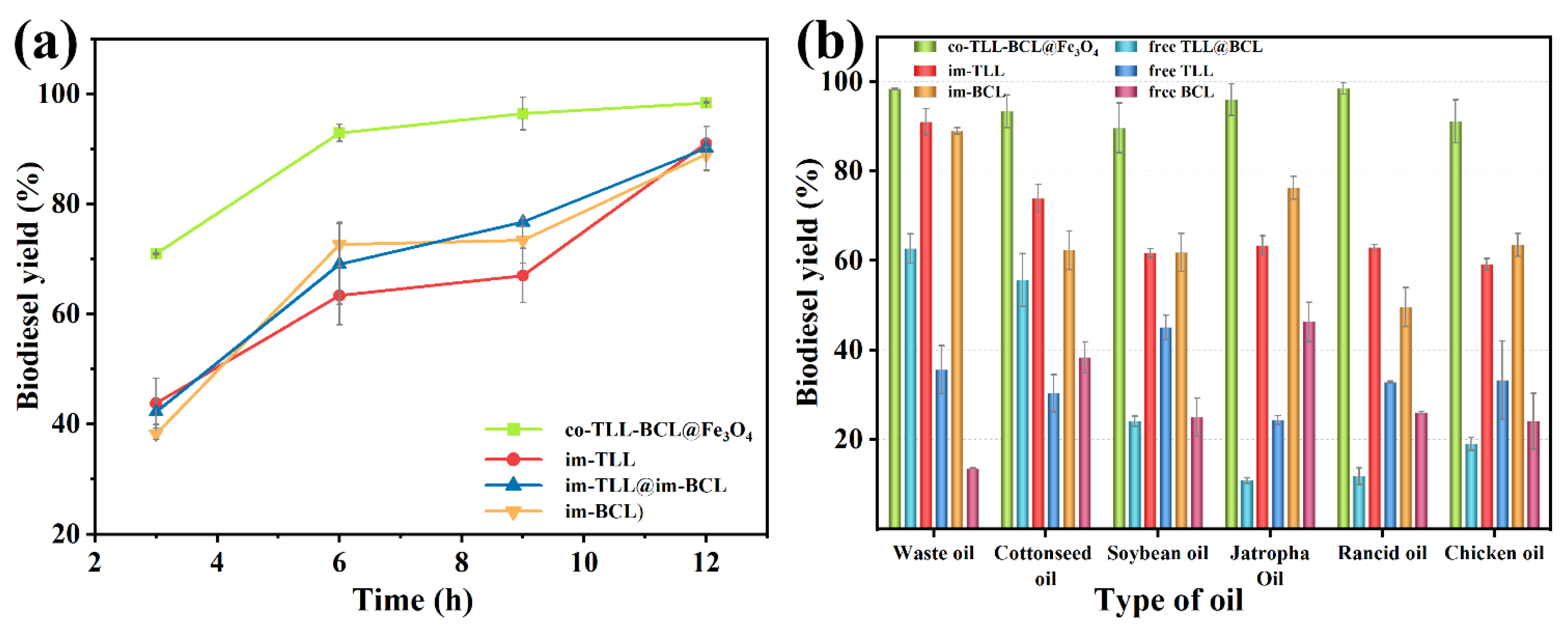
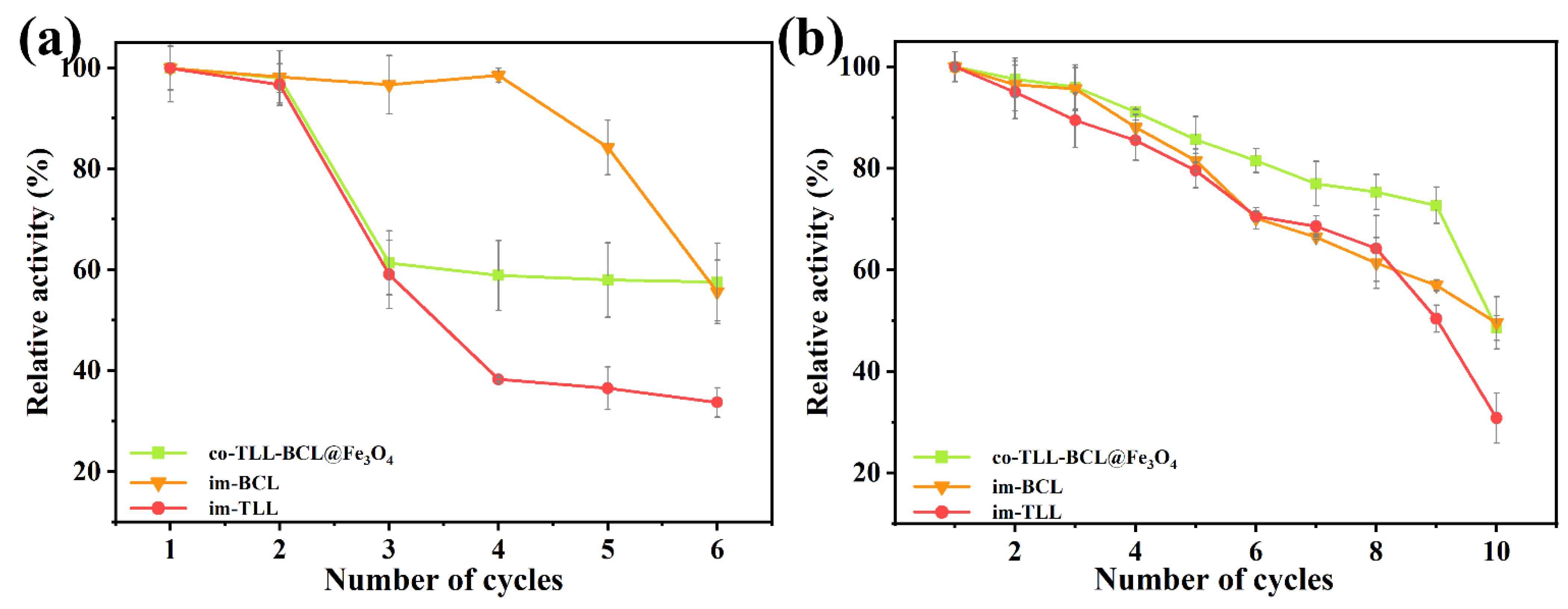
| Run | Actual Value of Variables | Actual Biodiesel Yield (%) | Predicted Biodiesel Yield (%) | ||
|---|---|---|---|---|---|
| A: Amount of Carrier (mg) | B: Cyclohexyl Isonitrile Dosage (μL) | C: BCL:TLL Ratio | |||
| 1 | 25 | 25 | 1:2.5 | 92.60 | 89.68 |
| 2 | 25 | 20 | 1:3.0 | 73.14 | 72.09 |
| 3 | 20 | 25 | 1:3.0 | 73.85 | 75.60 |
| 4 | 25 | 25 | 1:2.5 | 87.74 | 89.68 |
| 5 | 25 | 20 | 1:2.0 | 56.95 | 58.73 |
| 6 | 30 | 30 | 1:2.5 | 86.75 | 87.45 |
| 7 | 20 | 20 | 1:2.5 | 69.60 | 68.90 |
| 8 | 20 | 30 | 1:2.5 | 63.95 | 63.98 |
| 9 | 25 | 30 | 1:2.0 | 61.75 | 62.80 |
| 10 | 30 | 20 | 1:2.5 | 75.75 | 75.72 |
| 11 | 25 | 25 | 1:2.5 | 89.92 | 89.68 |
| 12 | 30 | 25 | 1:2.0 | 79.79 | 78.04 |
| 13 | 25 | 25 | 1:2.5 | 88.92 | 89.68 |
| 14 | 25 | 30 | 1:3.0 | 76.63 | 74.85 |
| 15 | 20 | 25 | 1:2.0 | 64.15 | 63.07 |
| 16 | 30 | 25 | 1:3.0 | 89.85 | 90.93 |
| 17 | 25 | 25 | 1:2.5 | 89.22 | 89.68 |
| Source | Sum of Squares | df | Mean Square | F-Value | p-Value Prob > F | |
|---|---|---|---|---|---|---|
| Model | 2097.32 | 9 | 233.04 | 52.43 | <0.0001 | significant |
| A-Amount of carrier | 458.89 | 1 | 458.89 | 103.25 | <0.0001 | |
| B-Cyclohexyl isonitrile dosage | 23.26 | 1 | 23.26 | 5.23 | 0.0560 | |
| C-BCL:TLL ratio | 322.96 | 1 | 322.96 | 72.67 | <0.0001 | |
| AB | 69.31 | 1 | 69.31 | 15.59 | 0.0055 | |
| AC | 0.032 | 1 | 0.032 | 7.29 × 10−3 | 0.9343 | |
| BC | 0.43 | 1 | 0.43 | 0.097 | 0.7651 | |
| A2 | 36.33 | 1 | 36.33 | 8.17 | 0.0244 | |
| B2 | 682.33 | 1 | 682.33 | 153.52 | <0.0001 | |
| C2 | 407.07 | 1 | 407.07 | 91.59 | <0.0001 | |
| Residual | 31.11 | 7 | 4.44 | |||
| Lack of Fit | 17.97 | 3 | 5.99 | 1.82 | 0.2827 | not significant |
| Pure Error | 13.14 | 4 | 3.28 | |||
| Cor Total | 2128.43 | 16 | ||||
| R2 | 0.9854 | |||||
| Adjusted R2 | 0.9666 | |||||
| Predicted R2 | 0.8552 |
| Lipase | Support | Method | Oil | Reaction Conditions | Yield | Reusability | Ref. |
|---|---|---|---|---|---|---|---|
| Candida rugosa (CRL) and Rhizomucor miehei (RML) | poly hydroxybutyrate (combined use) | Adsorption | Waste cooking oil | 1% of mixed lipase, 5% water content, methanol/oil = 6:1, 45 °C, 24 h | 96.5% | 6 cycles, 60% relative activity | [9] |
| Candida rugosa (CRL) and Rhizomucor miehei (RML) | poly hydroxybutyrate (combined use) | Adsorption | Chicken waste oil | 2.5% wt enzyme, 5% water content, methanol/oil = 6:1, 40 °C, 12 h | 97.1% | 7 cycles, more than 50% relative activity | [11] |
| Burkholderia cepacia (BCL) and Thermomyces lanuginosus (TLL) | silica hydroxyethylcellulose matrix (combined use) | Covalent bonding | Palm kernel oil | 25% wt enzyme, ethanol/oil = 8:1, 45 °C, space-time of 16 h | 98% | - | [13] |
| Rhizomucor miehei (RML) and Candida antarctica B (CALB) | epoxy-functionalized silica gel (co-immobilization) | Covalent bonding | Palm oil | -, water 3% (w/w of oil) methanol/oil = 5.9 (2 steps), 40 °C, 33.5 h CALB:RML ratio (2.5:1), | 88% | - | [8] |
| Candida antarctica B (CALB) and Thermomyces lanuginose (TLL) | epoxy-functionalized silica gel (co-immobilization) | Covalent bonding | Palm oil | -, methanol/oil = 2.3, t-butanol (45 wt%), 47 °C, 24 h | 94% | - | [10] |
| Burkholderia cepacia (BCL) and Thermomyces lanuginosus (TLL) | epoxy-functionalized magnetic particles (co-immobilization) | Covalent bonding | Waste oil | lipase 8% (w/w of oil), no water, methanol/oil = 6:1, 30 °C, 12 h | 98.5% | 9 cycles, 77% relative activity | This work |
| Factors (Independent Variable) | Levels | ||
|---|---|---|---|
| Low (−1) | Medium (0) | High (1) | |
| Amount of carrier (mg) | 20 | 25 | 30 |
| Cyclohexyl isonitrile dosage (μL) | 20 | 25 | 30 |
| BCL:TLL mass ratio | 1:2.0 | 1:2.5 | 1:3.0 |
Disclaimer/Publisher’s Note: The statements, opinions and data contained in all publications are solely those of the individual author(s) and contributor(s) and not of MDPI and/or the editor(s). MDPI and/or the editor(s) disclaim responsibility for any injury to people or property resulting from any ideas, methods, instructions or products referred to in the content. |
© 2023 by the authors. Licensee MDPI, Basel, Switzerland. This article is an open access article distributed under the terms and conditions of the Creative Commons Attribution (CC BY) license (https://creativecommons.org/licenses/by/4.0/).
Share and Cite
Wang, Q.; Zhang, R.; Liu, M.; Ma, L.; Zhang, W. Co-Immobilization of Lipases with Different Specificities for Efficient and Recyclable Biodiesel Production from Waste Oils: Optimization Using Response Surface Methodology. Int. J. Mol. Sci. 2023, 24, 4726. https://doi.org/10.3390/ijms24054726
Wang Q, Zhang R, Liu M, Ma L, Zhang W. Co-Immobilization of Lipases with Different Specificities for Efficient and Recyclable Biodiesel Production from Waste Oils: Optimization Using Response Surface Methodology. International Journal of Molecular Sciences. 2023; 24(5):4726. https://doi.org/10.3390/ijms24054726
Chicago/Turabian StyleWang, Qian, Rongjing Zhang, Maogen Liu, Lin Ma, and Weiwei Zhang. 2023. "Co-Immobilization of Lipases with Different Specificities for Efficient and Recyclable Biodiesel Production from Waste Oils: Optimization Using Response Surface Methodology" International Journal of Molecular Sciences 24, no. 5: 4726. https://doi.org/10.3390/ijms24054726




